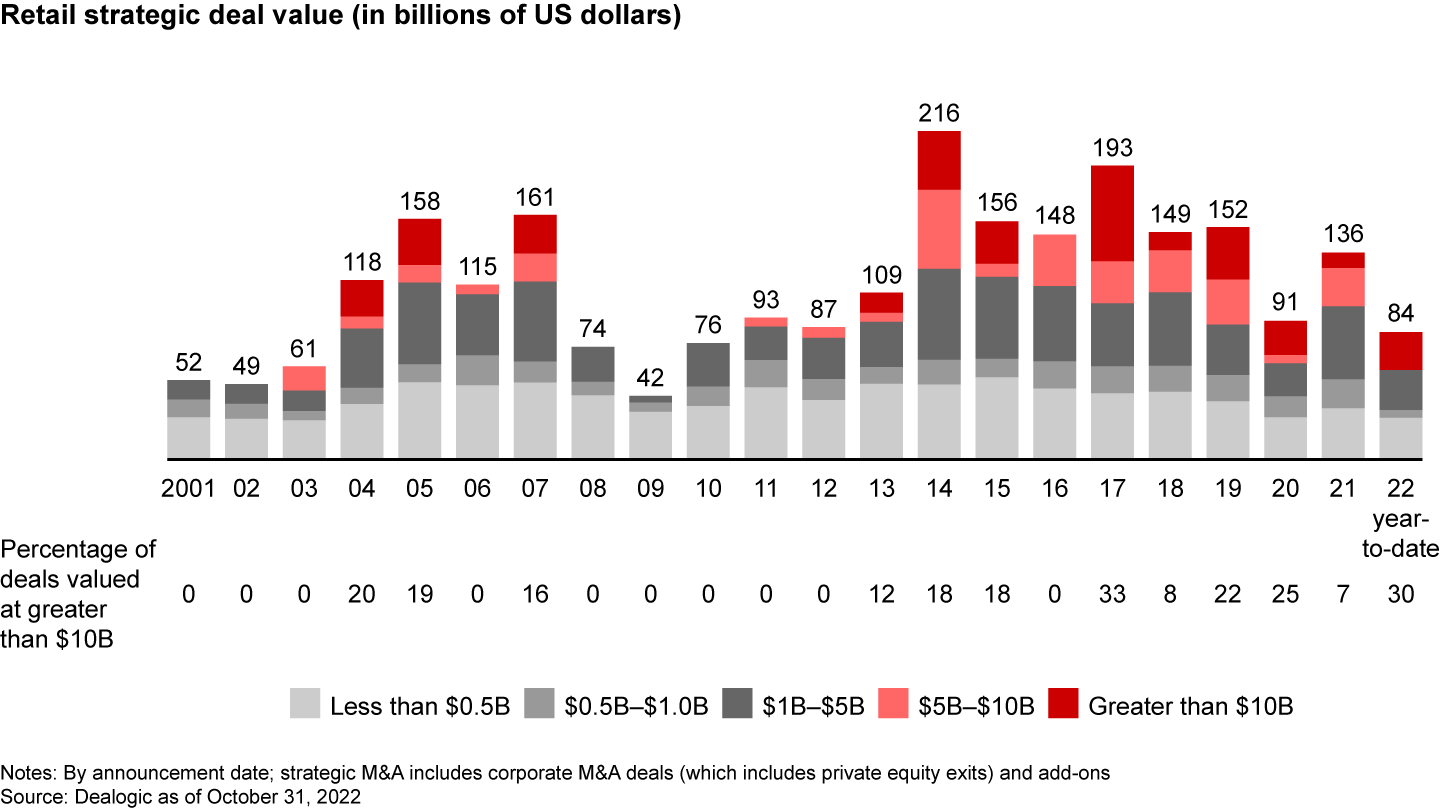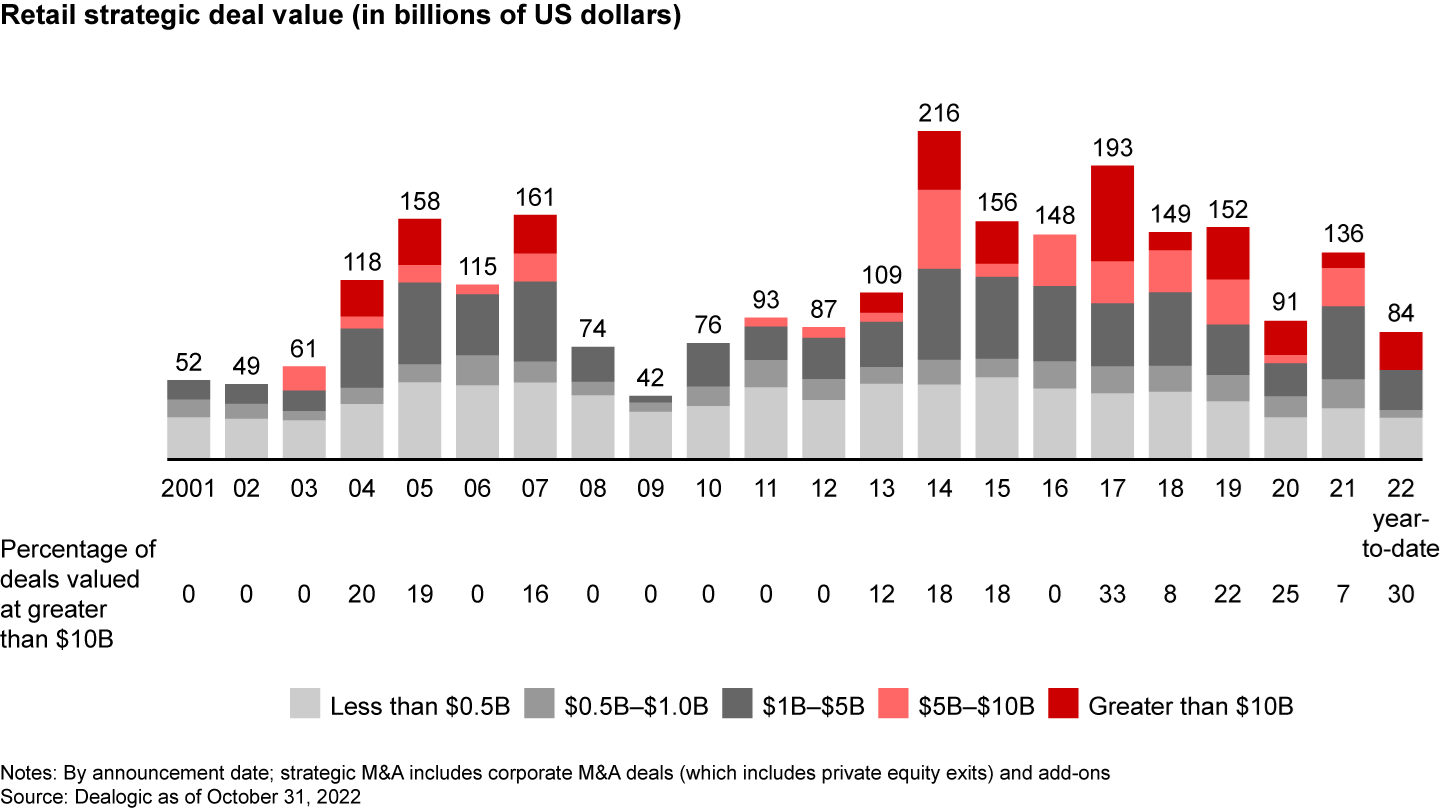M&A Report

한눈에 보기
- We expect companies to draw on record levels of cash amassed during the Covid-19 pandemic and take advantage of decade-low multiples to pursue M&A deals in 2023.
- With growth in their traditional businesses slowing, retailers will need to turn to beyond-trading activity for growth, which is poised to become the biggest force in retail M&A.
- Beyond-trading revenue will account for 40% of retailers’ revenue and more than half of industry profits by 2030.
- Retailers can pursue beyond-trading revenue via category expansion, third-party marketplaces, consumer service ecosystems, and business-to-business services.
This article is part of Bain's 2023 M&A Report.
In many ways, the retail industry’s rapid evolution feels like a blur. Traditional retailers are more aggressively upping their digital game while digital natives (think Warby Parker, Gopuff, and Deliveroo) are racing to hone the classic retail capabilities patiently built up over decades by incumbent rivals. This is happening at a time when profit pools are on the verge of massive changes that will make them virtually unrecognizable as more and more retailers see a future in nontrading activity.
Indeed, as growth from their traditional business continues to slow, retailers are moving in new directions—for example, to marketplaces that generate commissions by linking third-party sellers to customers; or to business-to-business (B2B) services and products that bolster new revenue streams from existing assets, including logistics infrastructure services, customer data monetization, and underexploited advertising channels on apps and websites via new retail media networks. Overall, we forecast that such beyond-trading activities will account for 40% of revenue and more than half of industry profits in 2030.
Retailers that achieve outsized total shareholder returns get two things right.
As retailers shift their business mix toward beyond-trading revenue, M&A has a critical role to play. Retailers will rediscover scale deals to build local and global leadership positions and generate the cost synergies that can help them invest in adjacencies that will produce the lion’s share of future growth. At the same time, they are seeking out scope deals to help them grow beyond their traditional trade business. They’re attempting this balancing act as they navigate an uncertain macroeconomic environment that makes it imperative to excel at the basics of retailing.
Retailers that achieve outsized total shareholder returns get two things right: They engage in frequent and material M&A (in our long-term study of M&A trends, we call such companies “mountain climbers”), and they take advantage of economic downturns to make bold moves in M&A. Indeed, in the last half of 2022, we began to see early signals of a resurgence of scale deals as evidenced by the headlines generated by the Kroger-Albertsons merger announcement. Companies are beginning to draw on record levels of cash amassed during the Covid-19 pandemic and decade-low multiples—lower than in any other major industry, in fact—to pursue scale deals (see Figure 1).
Given the dip in large-scale retail deals over the past few years, the industry is ripe for a rebound


As companies make these scale moves, they also are playing an equally ambitious game to assess and buy new capabilities and technologies in scope deals. While the majority of retail M&A value over the past two years involved scale deals, the majority of large deal volume was actually in scope deals. Much of that was aimed at hastening the convergence of traditional store-first retailers playing catch-up with their digitally native disrupters in innovation and technology—all while tech-first digital natives bought companies to develop capabilities that would enable them to build a successful physical store presence.
The quest for beyond-trading revenue streams by traditional retailers could be the biggest force behind scope M&A in the years ahead. With the tailwinds from Covid-19 waning and organic growth slowing, we’ll see more retailers buying to diversify into higher-growth revenue streams—in some cases leveraging an existing asset that they’ve been sitting on (e.g., their data). It’s been eight years since Kroger acquired the majority of Dunnhumby, the data analysis firm that provides it with valuable customer insights. Now, Kroger is referencing alternative profit businesses such as retail media and customer insights as core components of the deal thesis for its proposed deal for Albertsons. There are relatively small deals with a beyond-trading aim, too. Consider American Eagle Outfitters’ purchase of Quiet Logistics for approximately $350 million in 2021. To get into the game of developing a new growth engine (what we refer to as an Engine 2 business), some companies are divesting parts of their business that no longer support their strategy or that have become operationally inefficient.
The quest for beyond-trading revenue streams by traditional retailers could be the biggest force behind scope M&A in the years ahead.
This major shift to beyond-trading revenue comes in four varieties. We’ll look at them one by one.
Category and format expansion beyond traditional retail: This was the route taken by Nike in late 2021 when it acquired RTFKT, a company that relies on game engines, nonfungible tokens (NFTs), blockchain authentication, and augmented reality to deliver innovative virtual products and experiences. And there’s a consistent push by retailers acquiring their way into healthcare, with Amazon’s intent to buy One Medical last year on the heels of Best Buy’s purchase of Current Health in late 2021. In another variant, duty-free retailer Dufry and Italian airport and motorway caterer Autogrill announced a deal to merge in 2022.
Third-party marketplaces: In these deals, companies enable businesses to sell through their own platforms. When eBay announced its deal for NFT marketplace KnownOrigin in June, it described the purchase as being part of its “tech-led reimagination.” A host of retailers, such as Macy’s, Galeries Lafayette, Auchan, and Carrefour, are using Mirakl to bolt on marketplaces.
Consumer service ecosystems and super apps: Retailers turn to M&A to pursue revenue from broader consumer discretionary spending and to become the go-to app for every consumer need. For example, Meituan’s one-stop shop app maximizes stickiness, making it harder for customers to leave the ecosystem. That was the reasoning behind South Korean search company Naver’s announced plans to acquire secondhand apparel marketplace Poshmark for $1.2 billion last year.
Expanding into B2B revenue streams: In this growing shift, retailers are leveraging their existing assets and capabilities for external commercialization to generate alternative B2B revenue streams. Amazon pioneered this activity with Amazon Web Services, which provides on-demand cloud computing platforms. India’s Flipkart accelerated its move in this direction last year by initiating a multiyear strategic alliance with Google Cloud. The examples of retailers rapidly entering retail media are many: Walmart Connect, Target’s Roundel, and Lowe’s One Roof Media Network all provide suppliers personalized and targeted activation of their broad consumer bases; JD.com’s JD Logistics and Amazon’s Amazon Global Logistics provide supply chain and logistics services.
Growing beyond traditional trade is a must-have for all retailers. The question is: How do you do it best? Winning retailers will use data to identify which beyond-trading opportunities will promote growth, which to target, and how to get there (i.e., whether to build or buy or partner). Even the biggest retailers are finding that building can be too slow, capital intensive, and, when they lack in-house talent, especially risky. That’s why more are opting for partnerships or outright acquisitions.
Whether the goal is to build scale for leadership or to pursue scope M&A to add new revenue and profit streams, the best M&A deals will start by asking a handful of fundamental questions:
- How much more headroom do we have in our current core business, and what is our best path toward gaining local or global relative market share?
- Are there affordable assets on the market that would accelerate our path to build scale?
- What will our addressable profit pool look like in three years? Five years? Ten years? How will customer needs shift, and do we have what it takes to compete and win share in that future?
- How will we get our fair share of the accelerating beyond-trading profit pool? Which diversified revenue streams are we best positioned to win in?
- What are our capability gaps, and what is on the wish list of priority capabilities? Do we have the ability to develop those capabilities internally, or is it a good time to be refreshing our M&A shopping list (with a future-back lens) given the price of assets?
- How should we prioritize?